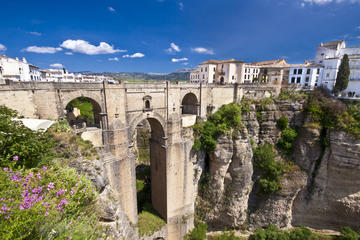Puente Nuevo
TIME : 2016/2/22 14:10:10

Puente Nuevo
The Puente Nuevo (New Bridge) is a major feat of 18th-century engineering uniting Ronda’s old and new towns over El Tajo Gorge, the sheer limestone ravine that descends to the craggy bed of the Guadalevín River 390 ft (120 m) below. Spanish architect José Martín de Aldehuela designed the bridge and construction began in 1759 but it was 42 years in the making. During that time, more than 50 workers were killed falling into the gorge.
The best photo opportunity and viewpoint across the gorge is bang in the middle of the Puente Nuevo – just don’t step back into the traffic. The chamber built into the bridge’s central arch below the road was once used as a jail and political prisoners were reputedly thrown out of the windows to meet a gory death on the rocks below. Today is has a more pacific role as a small museum detailing the history and construction of the bridge.
To the south of the Puente Nuevo lies the gleaming Moorish old town, a
pueblo blanco (white town) known as Le Ciudad and crammed with labyrinthine cobbled streets, wrought-iron window grilles and balconies, sparkling whitewash and painted shutters. Here lie most of Ronda’s historic sites, including the Mondragón Palace and the Casa del Rey Moro. Over the bridge to the north is the new(er) town of El Mercadillo, Ronda’s modern commercial heart, with plenty of quality stores, tapas bars and the oldest bullring in Spain on Calle Virgen de la Paz, inaugurated in 1785.
Practical Info
Ronda is small enough to explore on foot. Parking is plentiful around El Mercadillo and outside the old town walls. The best time to see the Puente Nuevo is when it is beautifully floodlit at night. The bullring and museums are open daily 10am-8pm.
